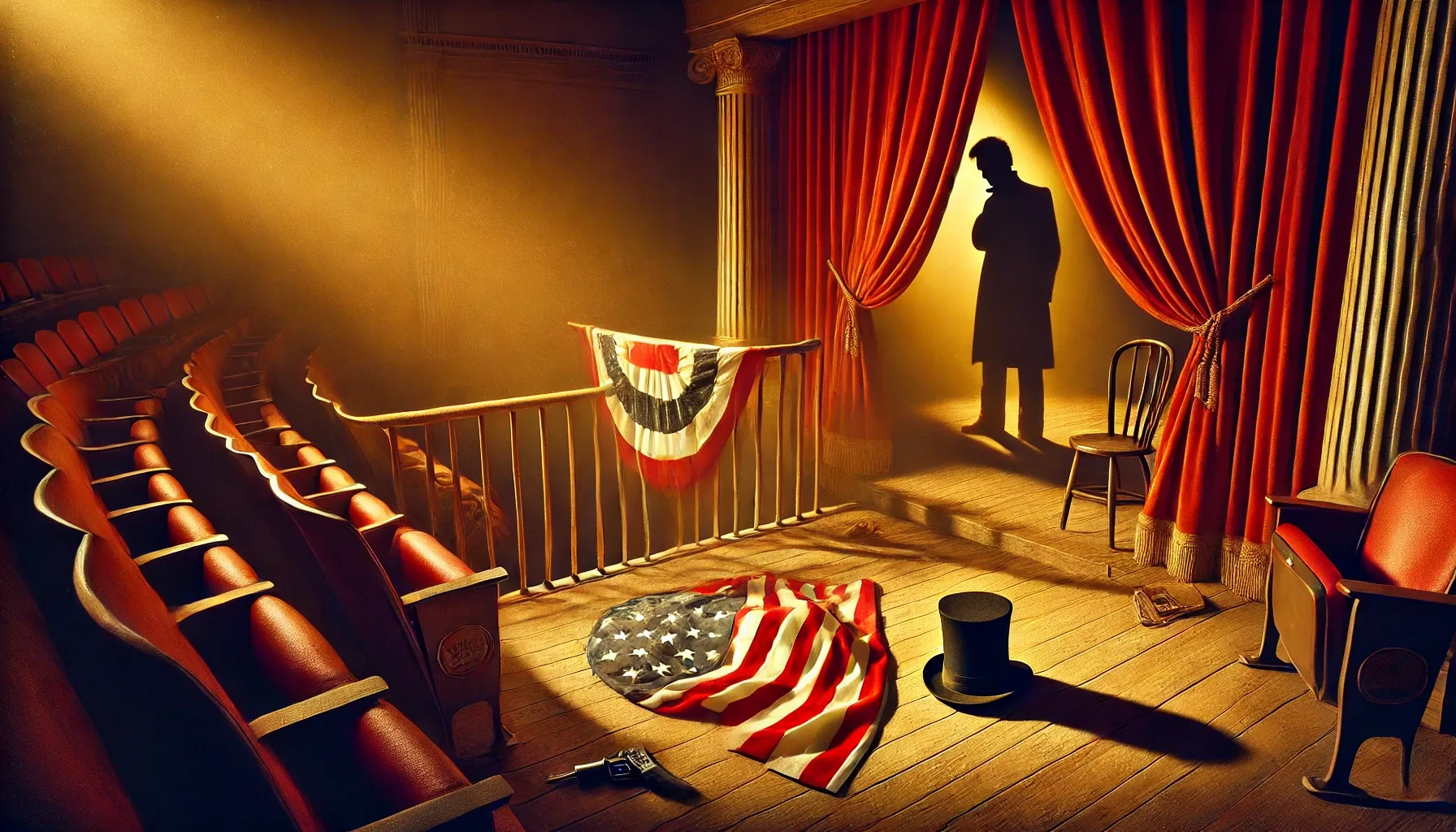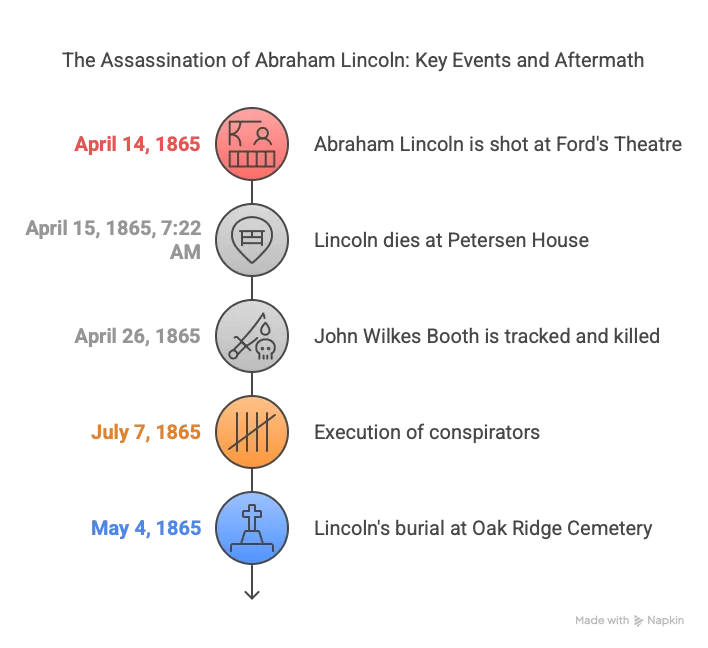On This Day Today
The Assassination of Abraham Lincoln
Last Updated
13th April, 2025
Date Published
13th April, 2025
Share This Post With Someone

- Date and Location:
- Abraham Lincoln was assassinated on April 14, 1865, at Ford’s Theatre in Washington, D.C., during a performance of the comedy Our American Cousin.
- He was shot in the head and died the following morning, April 15, 1865, at 7:22 AM in the Petersen House across the street.
- Assassin:
- John Wilkes Booth, a renowned actor and Confederate sympathizer, carried out the assassination.
- Booth was born in Maryland, part of a distinguished acting family, and harbored deep resentment toward Lincoln and abolitionists.
- Weapon and Execution:
- Booth used a .44-caliber derringer pistol to shoot Lincoln in the back of the head while he sat in the presidential box.
- After shooting, Booth leaped from the box to the stage, reportedly shouting “Sic semper tyrannis!” (Thus always to tyrants) or “The South is avenged!” and broke his left leg in the fall.
- Conspiracy:
- The assassination was part of a larger plot to revive the Confederate cause by eliminating key Union figures.
- Booth planned to assassinate Lincoln, Vice President Andrew Johnson, and Secretary of State William H. Seward simultaneously.
- Lewis Powell, assisted by David Herold, was assigned to kill Seward, while George Atzerodt was tasked with killing Johnson.
- Other Attacks:
- Lewis Powell attacked Seward at his home, slashing him repeatedly with a knife. Seward survived, though his face was permanently disfigured.
- George Atzerodt failed to act on his assignment to kill Johnson and fled.
- Victims in the Presidential Box:
- Lincoln was accompanied by his wife, Mary Todd Lincoln, Major Henry Rathbone, and Rathbone’s fiancée, Clara Harris.
- Booth stabbed Rathbone in the arm during a struggle before escaping.
- Booth’s Escape and Death:
- Booth fled Ford’s Theatre, accompanied by David Herold, and hid in Maryland and Virginia.
- After a massive manhunt involving 10,000 federal troops, Booth was tracked to a Virginia farm on April 26, 1865.
- Refusing to surrender, Booth was shot—either by a soldier or himself—and died shortly after.
- Medical Response:
- Dr. Charles Leale examined Lincoln immediately after the shooting and determined the wound was fatal.
- Lincoln was carried to the Petersen House, where he was attended by multiple doctors until his death.
- Funeral and National Mourning:
- Lincoln’s body lay in state at the White House and U.S. Capitol before a 13-day funeral train journey to Springfield, Illinois.
- The procession stopped in cities like Philadelphia and New York, where millions paid their respects.
- Lincoln was buried on May 4, 1865, at Oak Ridge Cemetery alongside his son William Wallace Lincoln.
- Trial of Conspirators:
- Eight conspirators were tried by a military commission for their roles in the plot.
- David Herold, Lewis Powell, George Atzerodt, and Mary Surratt (who ran a boardinghouse linked to the conspirators) were found guilty and hanged on July 7, 1865.
- Samuel A. Mudd (who treated Booth’s leg), Michael O’Laughlen, and Samuel Arnold received life sentences.
- Edman Spangler, a theater worker, was sentenced to six years.
- Booth’s Background:
- Booth grew up in Maryland, a border state, and was popular as an actor in Richmond, Virginia.
- Despite promising his mother not to fight for the Confederacy, he was initiated into the pro-Confederate Knights of the Golden Circle in 1860.
- His hatred for Lincoln intensified as the Civil War progressed, particularly after Confederate defeats.
- Prior Plots:
- Booth initially planned to kidnap Lincoln in March 1865 to exchange him for Confederate prisoners but failed when Lincoln’s schedule changed.
- The collapse of the Confederacy in April 1865 prompted Booth to devise the assassination plot.
- Lincoln’s Premonitions:
- Days before his death, Lincoln shared a dream with his cabinet about a corpse in the White House, identified as the President, killed by an assassin.
- He also dreamed of a vessel moving toward an indefinite shore, a recurring vision he associated with major Civil War events.
- Impact of the Assassination:
- The assassination occurred days after the Civil War ended with General Robert E. Lee’s surrender at Appomattox on April 9, 1865, deepening national grief.
- It disrupted Reconstruction efforts, as Andrew Johnson’s presidency took a different course from Lincoln’s plans.
- Lincoln’s death cemented his legacy as a martyr for the Union and abolition, though he faced criticism in the South for his policies.
- Historical Context:
- The assassination took place during a performance attended by Lincoln to celebrate the Union’s victory.
- Booth tampered with the presidential box’s door earlier that day to ensure easy access during the play’s third act.
- Cultural and Political Significance:
- The event highlighted deep divisions in post-Civil War America, with Booth’s act symbolizing lingering Confederate resistance.
- It led to increased security measures for U.S. presidents and reshaped public perceptions of political violence.

Key Terms:
- Abraham Lincoln: 16th U.S. President, assassinated in 1865, known for abolishing slavery and preserving the Union.
- John Wilkes Booth: Actor and Confederate sympathizer who assassinated Lincoln.
- Ford’s Theatre: Washington, D.C., venue where Lincoln was shot during Our American Cousin.
- Sic semper tyrannis: Latin phrase meaning “Thus always to tyrants,” shouted by Booth after the shooting.
- Conspiracy: Plot to kill Lincoln, Johnson, and Seward to destabilize the U.S. government.
- Mary Surratt: Boarding house owner executed for her role in the conspiracy.
- Petersen House: Location across Ford’s Theatre where Lincoln died.
- Military Commission: Tribunal that tried and sentenced the conspirators.
- Knights of the Golden Circle: Pro-Confederate secret society Booth joined.
- Reconstruction: Post-Civil War period of rebuilding and integrating the South, impacted by Lincoln’s death.